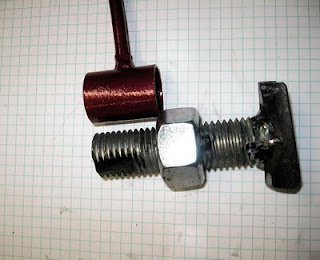


Following up on the theme of making edge tools with tool steel these are some ideas about making the tangs with which they will mount in the fly press.
My fly press is a small one but just right for my purposes - the Goldilocks Principal. The socket in the ram which seats the top tools has a 1" diameter. Depending upon the required finished length of the tool I use either 1" x 1.5" bolts (shorter tools) or 1" thread rod (long tools).
The tang needs to seat as deep as possible to provide the lateral support but it should not be able to bottom out and upset the end of the tang or damage the base of the socket. All the vertical force on the top tool should bear broadly on the face of the ram. When using the thread rod I use a depth gauge made from a piece of tube which fits over the 1" rod. A 1" - 8 nut is screwed down to expose just the right length of tang and then welded in place with the MIG welder.
If I need 60º Indexing, 5/8” - 11 coupler nuts work great as top tangs. Usually the tool fits in only one or two rotational positions so I just grind a flat spot to the depth of the threads so the set screw will have a point to seat nicely in those positions.
The tangs for the base socket are made from 7/8" - 9 nuts if a slightly loose fit is tolerable or a 1" section of 1.5" schedule 40 pipe with a 1/8" slit cut out when a tight fit is required. There are 1/2" slots in the base frame on both sides of the bottom socket so "outrigger" bars can be attached to the bottom tang and extend out to drop into one or both of those slots to securely fix the rotational position of the bottom tool if needed.
When attaching a tool to the top tang, such as was described in the previous post, I allow for a standoff gap and make a single tack which permits me to double check and adjust the orientation before final welding.
It seems important to pay careful attention to the condition of the set screw in the ram. I replaced the original one with a grade 8 bolt and made a custom wrench from a socket wrench with a welded "T"-handle and it hangs on a cord from the stand close at hand. Inspecting the tangs for any fret marks from the screw may show there is undesirable movement of the tang which could damage the screw. If the end of the screw became upset or the end threads damaged it could be very difficult to remove the screw without damaging the threads in the ram. As usual it is easier to prevent a problem than fix one.

No comments:
Post a Comment